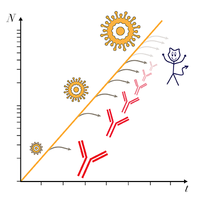感染和接种过程中的非平衡抗原识别
IF 11.6
1区 物理与天体物理
Q1 PHYSICS, MULTIDISCIPLINARY
引用次数: 0
摘要
对急性原发性感染的最初免疫反应是一个抗原增殖、幼稚 B 细胞分子识别及其随后克隆扩增的耦合过程。这一过程包含一个基本问题:识别指数随时间变化的抗原信号。在这里,我们表明,高效的免疫反应必须严格限制在具有高抗原结合亲和力的 B 细胞系中。我们提出了一种调整校对机制,用于对新抗原的初级识别,其中的分子识别机制适应了免疫库的复杂性。我们的研究表明,这一过程能对抗原进行有效、特异和快速的识别,并保持基因上不同的 B 细胞系谱,作为亲和力成熟的输入。我们的分析将原发性感染的增殖-识别动态映射为一个广义的 Luria-Delbrück 过程,类似于经典波动实验的动态。这一映射建立了信号识别动态与进化之间的联系。我们由此推导出活化免疫复合物的统计数据:抗原结合亲和力、预期大小和活性 B 细胞克隆的频率都与幂律有关,它们定义了广义 Luria-Delbrück 过程的类别。它们的指数取决于抗原和 B 细胞的增殖率、校对步骤的数量以及幼稚细胞群的系谱密度。我们将模型扩展到时空过程,包括疫苗接种的扩散-识别动态过程。我们发现,激活小鼠免疫复合物的经验数据与涉及大约三个校对步骤的激活相一致。该模型预测了急性感染和疫苗接种的关键临床特征,包括精英中和者的出现和免疫老化的影响。更广泛地说,我们的研究结果将感染和疫苗接种确立为探究免疫复合物的全球结构和功能原理的新方法。本文章由计算机程序翻译,如有差异,请以英文原文为准。

Nonequilibrium Antigen Recognition during Infections and Vaccinations
The initial immune response to an acute primary infection is a coupled process of antigen proliferation, molecular recognition by naive B cells, and their subsequent clonal expansion. This process contains a fundamental problem: the recognition of an exponentially time-dependent antigen signal. Here, we show that an efficient immune response must be stringently constrained to B-cell lineages with high antigen binding affinity. We propose a tuned proofreading mechanism for primary recognition of new antigens, where the molecular recognition machinery is adapted to the complexity of the immune repertoire. We show that this process produces potent, specific, and fast recognition of antigens, maintaining a spectrum of genetically distinct B-cell lineages as input for affinity maturation. Our analysis maps the proliferation-recognition dynamics of a primary infection to a generalized Luria-Delbrück process, akin to the dynamics of the classic fluctuation experiment. This map establishes a link between signal recognition dynamics and evolution. We derive the resulting statistics of the activated immune repertoire: Antigen binding affinity, expected size, and frequency of active B-cell clones are related by power laws, which define the class of generalized Luria-Delbrück processes. Their exponents depend on the antigen and B-cell proliferation rate, the number of proofreading steps, and the lineage density of the naive repertoire. We extend the model to include spatiotemporal processes, including the diffusion-recognition dynamics of a vaccination. Empirical data of activated mouse immune repertoires are found to be consistent with activation involving about three proofreading steps. The model predicts key clinical characteristics of acute infections and vaccinations, including the emergence of elite neutralizers and the effects of immune aging. More broadly, our results establish infections and vaccinations as a new probe into the global architecture and functional principles of immune repertoires.
求助全文
通过发布文献求助,成功后即可免费获取论文全文。
去求助
来源期刊

Physical Review X
PHYSICS, MULTIDISCIPLINARY-
CiteScore
24.60
自引率
1.60%
发文量
197
审稿时长
3 months
期刊介绍:
Physical Review X (PRX) stands as an exclusively online, fully open-access journal, emphasizing innovation, quality, and enduring impact in the scientific content it disseminates. Devoted to showcasing a curated selection of papers from pure, applied, and interdisciplinary physics, PRX aims to feature work with the potential to shape current and future research while leaving a lasting and profound impact in their respective fields. Encompassing the entire spectrum of physics subject areas, PRX places a special focus on groundbreaking interdisciplinary research with broad-reaching influence.
 求助内容:
求助内容: 应助结果提醒方式:
应助结果提醒方式:


